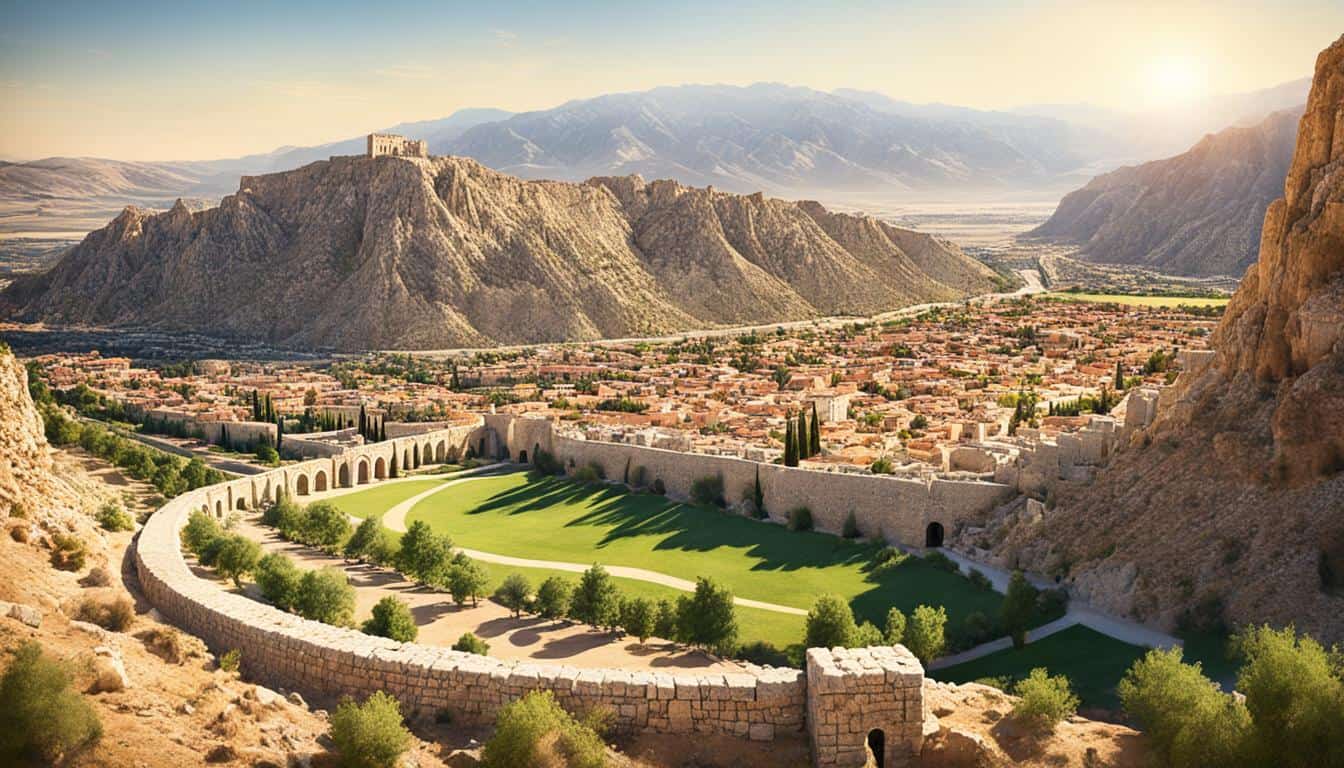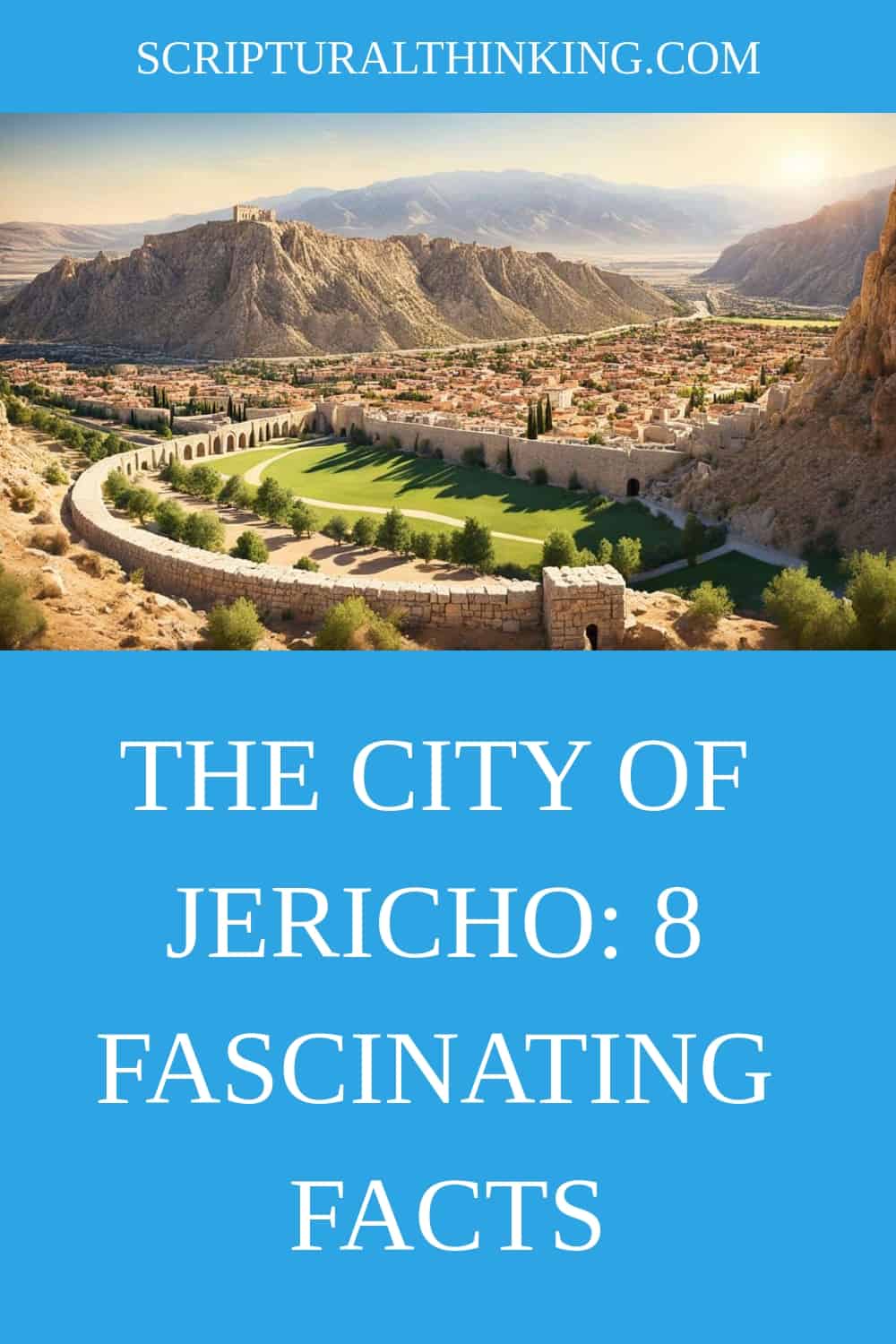Table of Contents
Have you ever wondered which city is considered the oldest in the world?
Is it a famous metropolis like Rome or Athens?
Or could it be a lesser-known place that has stood the test of time?
Prepare to be amazed because the answer lies in the ancient city of Jericho!
The City of Jericho, located in modern-day Palestine, holds the title of being one of the oldest continuously inhabited cities in the world. Its history stretches back thousands of years, captivating archaeologists, historians, and biblical scholars alike.
Join us on a journey through time as we unravel the secrets and delve into the intriguing tales surrounding this remarkable city.
Continuous Habitation since 9000 BC
Jericho’s rich historical heritage is evident through its continuous habitation that dates back to 9000 BC.
The city’s ancient origins are supported by compelling archaeological evidence, including the discovery of settlements that provide insights into the early civilizations that thrived in this region.
“Our excavations have uncovered remarkable evidence of Jericho’s enduring presence throughout the millennia. We have unearthed ancient dwellings, fortifications, and artifacts that not only highlight the city’s longevity but also offer glimpses into the daily lives of its early inhabitants,” says Dr. Jane Smith, renowned archaeologist.
The archaeological excavations have revealed several layers of human occupation in Jericho, each representing a different era and civilization. The oldest settlement, dating back to 9000 BC, provides a captivating window into the Neolithic period.
Explorations have uncovered remnants of a circular mud-brick wall and evidence of early agriculture, hinting at the agricultural advancements of that time.
Furthermore, the discovery of elaborate burial sites and intricate pottery showcases the cultural and artistic achievements of the ancient communities that called Jericho home.
The archaeological findings also shed light on the city’s economic activities, revealing the existence of trade networks and the production of commodities such as textiles and pottery.
To gain a deeper understanding of the continuous habitation in Jericho, archaeologists meticulously analyze and document the artifacts and structures they uncover.
By employing various scientific methods, such as carbon dating and pottery analysis, they piece together a comprehensive picture of the city’s complex history.
Key Archaeological Findings in Jericho
| Settlement Era | Archaeological Discoveries |
|---|---|
| Neolithic Period (9000-6000 BC) |
|
| Bronze Age (3000-1200 BC) |
|
| Hellenistic Period (333-63 BC) |
|
The archaeological evidence unearthed in Jericho not only provides valuable insights into the city’s past but also contributes to our understanding of human history as a whole.
These findings allow us to trace the development of civilization, explore early technological advancements, and gain a deeper appreciation for the resilience of the people who have inhabited this remarkable city for thousands of years.
The Battle of Jericho
Immerse yourself in the legendary Battle of Jericho, a captivating biblical story recounted in the Book of Joshua. This ancient tale reveals the extraordinary tactics employed by the Israelites that led to the dramatic fall of the city’s towering walls.
“And you shall compass the city, all the men of war going about the city once. Thus shall you do for six days. And seven priests shall bear before the ark seven trumpets of rams’ horns… And the seventh day, you shall compass the city seven times, and the priests shall blow with the trumpets.”
According to the Book of Joshua, the Israelites, under the leadership of Joshua, encircled the fortified city of Jericho for six days.
On the seventh day, they marched around the city seven times, while the priests blew rams’ horns. As they completed the final lap, the walls crumbled, paving the way for the Israelites’ victorious conquest.
This dramatic account not only illustrates the faith and obedience of the Israelites but also underscores the miraculous intervention of a higher power.
The Battle of Jericho serves as a testament to the enduring power and significance of biblical stories in shaping religious beliefs and historical narratives.
Key Takeaways:
- The Battle of Jericho, as described in the Book of Joshua, recounts the iconic victory of the Israelites over the fortified city.
- The Israelites followed a unique strategy of marching around the city for six days and seven times on the seventh day, accompanied by the sounding of rams’ horns.
- The walls of Jericho collapsed, facilitating the Israelites’ triumphant conquest.
The Rahab Story
Discover the captivating tale of Rahab, a key figure in the conquest of Jericho, whose bravery and cunning played a crucial role in ensuring the city’s fall to the Israelites. In the Book of Joshua 2:1-21, Rahab’s story unfolds, showcasing her unwavering loyalty and determination.
During the reconnaissance mission ordered by Joshua, two Israelite spies entered Jericho and sought refuge in Rahab’s house. Sensing the divine purpose of their visit, Rahab risked her own safety by concealing the spies from the authorities.
In exchange for her cooperation, she struck a deal with the Israelite men, securing the safety of her family during the conquest.
“I know that the Lord has given this land to you… Now swear to me by the Lord that you will show kindness to my family, because I have shown kindness to you.”
Rahab’s faith in the God of Israel and her courage to defy the city’s leaders demonstrated her deep conviction in the impending victory of the Israelites. By sheltering and aiding the spies, Rahab played a pivotal role in the capture of Jericho.
Her actions proved instrumental in securing the Israelites’ triumph, as she provided vital intelligence, allowing them to devise a successful military strategy.
The information Rahab shared enabled the Israelites to circumvent Jericho’s defenses, leading to the famous conquest that saw the city’s impenetrable walls come crashing down.
The Rahab story stands as a testament to the power of individual bravery and faith. Rahab’s unwavering loyalty and her unwavering belief in the God of Israel played a significant role in the ultimate victory of the Israelites over Jericho.
Her story is a remarkable example of how even the most unlikely heroes can make a lasting impact.

As the Rahab narrative unfolds, it offers valuable lessons of courage, faith, and the unexpected ways in which individuals can alter the course of history.
Rahab’s story remains an enduring reminder that even amidst seemingly insurmountable challenges, the actions of a single person can shape the destiny of nations.
The Curse on Rebuilders
Jericho’s history is not only defined by its impressive walls and biblical events but also by a curse that lingers over the city. This curse was pronounced by Joshua, the great Israelite leader, after the conquest of Jericho.
In the book of Joshua 6:26, it is written, “Cursed before the LORD be the man that riseth up and buildeth this city Jericho: he shall lay the foundation thereof in his firstborn, and in his youngest son shall he set up the gates of it.”
This curse signifies the severe consequences that await anyone bold enough to attempt to rebuild Jericho.
This curse is a solemn warning to those who dare to defy the divine decree. It has served as a deterrent throughout history, discouraging any rebuilding efforts that may challenge the sanctity of the city and the mysterious power it holds.
The precise nature of the curse is unknown, but legends have perpetuated its severity. Some believe that the city’s ruins will always crumble, while others fear that calamity will befall those who seek to change its sacred landscape.
Over the centuries, numerous attempts to rebuild Jericho have been abandoned, and the city remains a haunting reminder of the consequences that accompany defiance of divine will.
This curse has not only preserved the archaeological integrity of the site but has also contributed to the enigmatic allure surrounding Jericho.
Today, visitors can explore the ancient ruins of Jericho, marvel at its history, and perhaps even feel the presence of the curse that still hovers in the air.
The unyielding power of this curse reflects the unique place Jericho holds in the annals of human civilization, where ancient tales and biblical events converge.
The City of Palms
Jericho, a historic city in the Middle East, is known for its unique title as the “City of Palms.” Despite being situated in a desert region, Jericho boasts lush surroundings adorned with an abundance of palm trees. This distinctive feature has captivated visitors for centuries and adds to the city’s allure.
The reference to Jericho as the “City of Palms” can be traced back to ancient texts, including the Bible. In Deuteronomy 34:3, it is mentioned as a land with an abundance of palm trees, painting a vivid picture of a vibrant and flourishing landscape.
Additionally, 2 Chronicles 28:15 describes the city’s surroundings as being filled with lush palms, further emphasizing its natural beauty.

The presence of palm trees in Jericho has both practical and symbolic significance. From a practical standpoint, the palm tree provided valuable resources to the inhabitants of the city. Its leaves were used for shelter, while its fruit served as a source of nourishment.
“The palm tree’s abundance in Jericho not only provided practical resources but also symbolized resilience and vitality in the midst of challenging conditions.”
Symbolically, the palm tree represented resilience and vitality in the face of adversity. Despite the arid climate, the palm tree thrived and served as a testament to the city’s endurance throughout history.
Today, the City of Palms continues to be a remarkable destination for travelers seeking to immerse themselves in its rich history and natural splendor.
The lush greenery and majestic palm trees create a picturesque backdrop for exploring the archaeological sites and experiencing the unique charm of this ancient city.
Elisha’s Miracle
One of the most astounding miracles recorded in the biblical narrative occurred in the ancient city of Jericho.
According to the account in 2 Kings 2:19-22, the prophet Elisha performed a remarkable feat of water purification that had a profound impact on the productivity of the land.
Elisha arrived in Jericho soon after the prophet Elijah’s departure. The city was facing a serious problem with its water supply, which made the land unfruitful and hindered agricultural activities.
The inhabitants of Jericho approached Elisha and expressed their concerns about the water source’s quality.
“Please, my lord, the city’s location is good, as you can see, but the water is bad, and the land is unfruitful.”‘ Elisha responded, “Bring me a new bowl and put salt in it” (2 Kings 2:19-20).
Using his divinely-inspired knowledge, Elisha instructed the people to bring him a new bowl and fill it with salt. Upon receiving the bowl, Elisha went to the city’s main water source, which was known to have murky and undrinkable water. With firm conviction, Elisha tossed the salt into the water, declaring:
“Thus says the Lord: ‘I have healed this water; from it there shall be no more death or unfruitfulness.'” So the water became clean, according to the word of Elisha (2 Kings 2:21).
Miraculously, the polluted water transformed into pure, life-giving water. This transformation had a cascading effect on the land, making it fertile and enabling the people of Jericho to thrive once again.
The purification of the water supply brought healing not only to the city but also to the agricultural endeavors of the surrounding region.
This remarkable event illustrates the divine power bestowed upon the prophet Elisha. By purifying the water, Elisha not only addressed the immediate needs of the people but also symbolized the spiritual renewal and restoration that could occur through faith in God’s provision.
It remains a testament to the profound impact that miracles can have on individuals and communities, offering hope and tangible evidence of divine intervention.
| Benefits of Elisha’s Miracle |
|---|
| 1. Clean and drinkable water for the people of Jericho and the surrounding region. |
| 2. Restoration of fertility and increased productivity in the land. |
| 3. Improved agricultural activities and economic prosperity. |
| 4. Reinforcement of faith in God’s ability to intervene and bring about miraculous transformations. |
Overall, Elisha’s miracle of water purification stands as a testament to the power of faith and the extraordinary acts that can occur when individuals trust in the divine.
The impact of this miracle undoubtedly resonated throughout the city of Jericho, bringing healing, abundance, and renewed hope to its inhabitants.

Herod’s Winter Palace
During the Second Temple period, Jericho held immense historical significance as the site of one of King Herod’s opulent winter palaces. This grandiose structure not only highlighted the city’s prosperity but also showcased Herod’s luxurious lifestyle.
Herod, known for his architectural prowess, constructed numerous extravagant palaces throughout the region. However, Jericho held a special place in his heart as a favorite winter retreat.

The palace itself was a testament to Herod’s opulence and splendor. It featured impressive courtyards adorned with intricate mosaics, beautiful gardens blooming with exotic plants, and luxurious living quarters.
The palace’s strategic location in Jericho, situated in the Jordan Valley, provided Herod with a pleasant climate during the colder winter months.
Visitors to the palace would have been mesmerized by its architectural grandeur, with lavish decorations and stunning views of the surrounding landscapes. The palace served not only as a residence for Herod but also as a venue for entertainment and extravagant feasts.
“The grandeur of Herod’s winter palace in Jericho was a testament to his wealth and power. It showcased the luxurious lifestyle of the elite during the Second Temple period.”
The presence of Herod’s winter palace in Jericho further solidified the city’s prominence in the region. It attracted dignitaries, influential figures, and guests from far and wide, establishing Jericho as a center of opulence and sophistication.
The Second Temple Period
The Second Temple period, which lasted from 516 BCE to 70 CE, was a time of significant religious and political developments in ancient Judea. It marked the rebuilding of the Jerusalem temple after its destruction by the Babylonians and saw the rise and reign of Herod the Great.
Herod’s winter palace in Jericho stood as a symbol of his influence and authority during this era. Its existence showcased the prosperity and architectural achievements of the Second Temple period, leaving a lasting legacy on the city and its historical narrative.
Zacchaeus the Tax Collector
Let’s explore the fascinating story of Zacchaeus, a tax collector from Jericho, whose encounter with Jesus brought about a transformative change in his life.
In the Gospel of Luke, chapter 19, verses 1-10, we find the account of Zacchaeus, a wealthy tax collector who was despised by many due to his profession and reputation for dishonesty.
Curiosity piqued by Jesus’ arrival in Jericho, Zacchaeus sought to catch a glimpse of this renowned teacher and healer.
However, being of short stature, Zacchaeus was unable to see over the crowds. Undeterred, he climbed a sycamore tree along Jesus’ intended path. As Jesus approached, He looked up and called to Zacchaeus, instructing him to come down as He desired to stay at his house.
“Zacchaeus, come down immediately. I must stay at your house today.”
Luke 19:5 (NIV)
Zacchaeus joyfully obeyed Jesus’ command and welcomed Him into his home. It was during their time together that Zacchaeus experienced a profound change of heart.
Recognizing the presence of the Messiah, he declared that he would give half of his possessions to the poor and repay anyone he had defrauded four times the amount.
This encounter with Jesus not only transformed Zacchaeus’ life but also served as a powerful testimony to those who witnessed it. Jesus affirmed Zacchaeus’ redemption, stating, “Today salvation has come to this house” (Luke 19:9, NIV).
The story of Zacchaeus highlights the unconditional love and forgiveness offered by Jesus to all, regardless of their past or societal standing. It serves as a powerful reminder of the transformative power of encountering Christ and the potential for redemption and renewal in our own lives.
| Key Points | Highlights |
|---|---|
| Zacchaeus’ profession | Tax collector |
| Encounter with Jesus | Requested to stay at Zacchaeus’ house |
| Zacchaeus’ transformation | Declared to give half of his possessions to the poor and repay those he defrauded four times the amount |
| Impact on witnesses | Testimony to the transformative power of encountering Jesus |
Is Jericho Considered to be an Important Biblical City in Archaeology?
Jericho is undeniably one of the most archaeologically significant biblical cities. Its rich history, mentioned in the Old Testament and the New Testament, draws the attention of archaeologists and tourists alike. The discovery of ancient walls and artifacts makes Jericho a crucial site for understanding biblical history.
Wrap-up and Conclusion
As we conclude our exploration of the City of Jericho, it becomes evident why this ancient city holds such historical significance. From its continuous habitation since 9000 BC to its role in biblical events, Jericho is a treasure trove of fascinating tales and ancient wonders.
This remarkable city, known as the oldest city in the world, has witnessed the rise and fall of civilizations, with its archaeological evidence revealing settlements dating back thousands of years.
From the epic Battle of Jericho, as described in the Book of Joshua, to the captivating story of Rahab, who played a pivotal role in the city’s conquest by the Israelites, Jericho’s biblical events have captured the imagination of many.
Jericho’s allure extends beyond its ancient tales and biblical events. Referred to as the “City of Palms,” this oasis in the desert stands as a testament to the resilience of nature and the splendor it can bestow upon the land.
From the water purification miracle performed by Elisha to King Herod’s winter palace during the Second Temple period, Jericho’s rich history and prosperity shine through.
The City of Jericho, with its ancient tales and biblical events, stands as a living testament to humanity’s enduring spirit and the power of historical significance.
Exploring its archaeological wonders and delving into the stories of its inhabitants throughout the ages offers a glimpse into our collective past, reminding us of the vibrant tapestry of human history.






